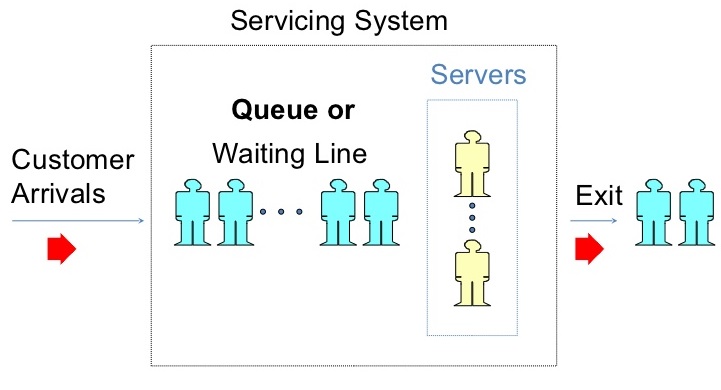Initial basic feasible solution of a transportation problem can be obtained by any of the following methods: 1. North—West corner rule The major advantage of the north—west corner rule method is that it is very simple and easy to apply. Its major disadvantage, however, is that it is not sensitive to costs and consequently yields poor initial solutions. The steps involved in determining an initial solution using north—west corner rule are as follows: Step 1. Write the given transportation problem in tabular form (if not given). Step 2. Go over to the north-west corner of the table. Suppose it is the (i, j)th cell. Step 3. Allocate min (ai, bj) to this cell. If the min (ai , bj) = ai, then the availability of the ith origin is exhausted and demand at the jth destination remains as bj-ai and the ith row is deleted from the table. Again if Continue reading
Management Science
Introduction to Crtical Path Analysis
Critical Path Analysis The OR techniques used for planning, scheduling and controlling the large and complex projects are often referred to as Critical Path Analysis or Network Analysis. A network is a graphical diagram consisting of a certain configuration of arrows and nodes for showing the logical sequence of various tasks( or activities) to be performed to achieve project objectives. Network analysis is the quite useful for designing, planning, coordinating, controlling and decision- making so that the project could be economically completed in the minimum possible time with the limited available resources two most popular form of this technique now used in many scheduling situations are the Critical Path Method (CPM) and Program Evaluation and Review Technique. (PERT) CPM: It differentiates between planning and scheduling. Planning refers to the determination of activities that must be accomplished and the order in which such activities should be performed to achieve the Continue reading
Modeling Techniques in Management Science
Management science is the science for managing and involves decision making. It utilizes what is controllable, and tries to predict what is uncontrollable in order to archive a specific objective. Science is a continuous search; it is a continuing generation of theories, models, concepts, and categories. Management science uses analytical methods to solve problems in areas such as production and operations, inventory management, and scheduling. Typical management science approach is to build a model for the problem being studied, such a model is often a mathematical model. Practical problems are often unstructured and lack clarification in definition of problem which makes mathematical modeling a challenge. Therefore modeling of a problem is important phase in problem solving technique. Once model is built, algorithms are used to solve problem. Various techniques are devised to model problem and solve it for possible solutions. Linear programming is one of the widely used modeling techniques. Continue reading
Waiting Lines and Queuing System in Management Science
Waiting in lines is a part of our everyday life. Waiting in lines may be due to overcrowded, overfilling or due to congestion. Any time there is more customer demand for a service than can be provided, a waiting line forms. We wait in lines at the movie theater, at the bank for a teller, at a grocery store. Wait time is depends on the number of people waiting before you, the number of servers serving line, and the amount of service time for each individual customer. Customers can be either humans or an object such as customer orders to be process, a machine waiting for repair. Mathematical analytical method of analyzing the relationship between congestion and delay caused by it can be modeled using Queuing analysis. Queuing theory provides tools needed for analysis of systems of congestion. Mathematically, systems of congestion appear in many diverse and complicated ways and Continue reading
Construction of Mathematical Decision Model
Mathematical model is an idealized representation expressed in mathematical symbols and expressions. A mathematical model of a business problem might be in the form of a set of equations and related mathematical expressions that describe the essence of the problem. An economic order quantity model is given by: EOQ = AO/C where A — annual requirement, O — ordering cost and C — carrying cost. A linear programming model is given by objective function: Say Maximize Z = 10a + 12b, subject to 2a + b < = 60, 3a + 4b < = 120, a, b > = 0, where a and are units of products A and B, respectively to be produced to maximize total contribution given individual contribution of Rs.10 per unit of A and Rs.12 per unit of B, the resource constraints being that resource 1 and 2 are available respectively to the extent Continue reading
Procedure for finding an optimum solution for transportation problem
The basic steps of the transportation method are: 1. To set up the transportation table. 2. Examine whether total supply equals total demand. If not, introduce a dummy row/column having all its cost elements as zero and Supply/Demand as the (+ive) difference of supply and demand. 3. To find an initial basic feasible solution. An initial BFS for a TP with m sources and n destinations must include m+n—1 basic variables. This initial solution may or may not be optimal. Thus, the initial solution in the transportation method serves the same purpose as the initial solution in the simplex method. There are a few methods to find the initial solution. The widely used methods for finding a initial solution are: North West corner rule Row minima method Column minima method Matrix minima method (Lowest cost entry method) Vogel’s approximation method (unit cost penalty method) (VAM) 4. To obtain an optimal Continue reading

